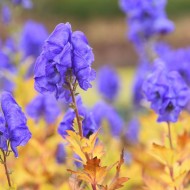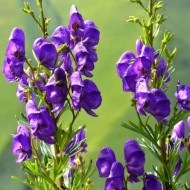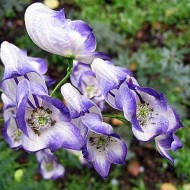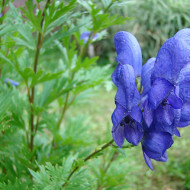We grow an elegant and deadly flower aconite in the country
Content
- 1 Description and distribution of aconite
- 2 Video "Aconite: types, agricultural technology and application"
- 3 Common types and varieties of aconite
- 4 The nuances of growing outdoors
- 5 Collection, procurement and storage of raw materials
- 6 The use of aconite in traditional medicine
- 7 The use of aconite in garden design
Description and distribution of aconite
Botanists attribute the culture to herbaceous perennials of the Buttercup family. Here is a description of the flower:
- Shrub species, stem height up to 30 cm. Some varieties are climbing vines, stretching 2 meters from the root.
- The foliage is rich green, the leaves are palmate, divided into parts, in some varieties they are double.
- The flowers form elongated inflorescences, the colors are white, blue and yellow. The inflorescences resemble knight's helmets in shape, because aconite has a different name - a wrestler.
- The flowering season begins at the end of summer and lasts more than a month.
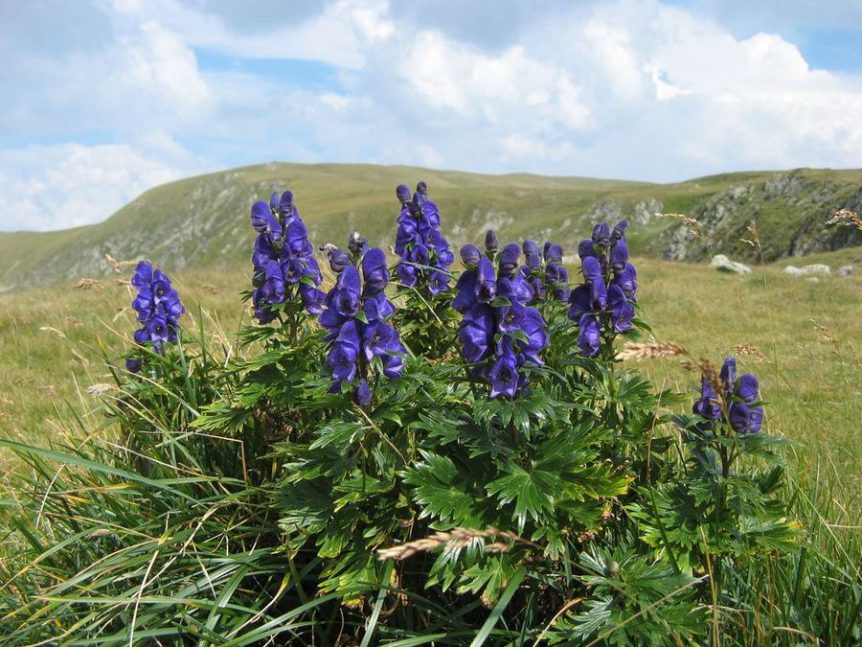
In nature, there are more than 300 varieties of flowers, the habitat is European and Asian countries, the American continent.
For instance:
- nodule aconite grows on the northern slopes of alpine meadows at an altitude of 2 km above sea level;
- A wolf-killer, containing tasty nectar, is pollinated by bumblebees, so the areas of culture and insects coincide.
Our flower is widespread in Altai and Western Siberia, it grows in Mongolia, Tibet, Pakistan.
Chemical composition and medicinal properties
The people have used the properties of the plant for many centuries. Hunters and warriors rubbed spear and arrowheads with grasses, and in folk medicine they made decoctions from culture. Hence the popular names of aconite - wolf-killer and wolf root, dog's death, king-potion.
The main component of culture is the alkaloid aconitine. Refers to non-protein poisons, has a neurotoxic effect. Has the following properties:
- quickly absorbed by the intestinal mucosa, spreads through the tissues;
- violates the permeability of cell membranes, leading to respiratory paralysis;
- leads to the death of the body.
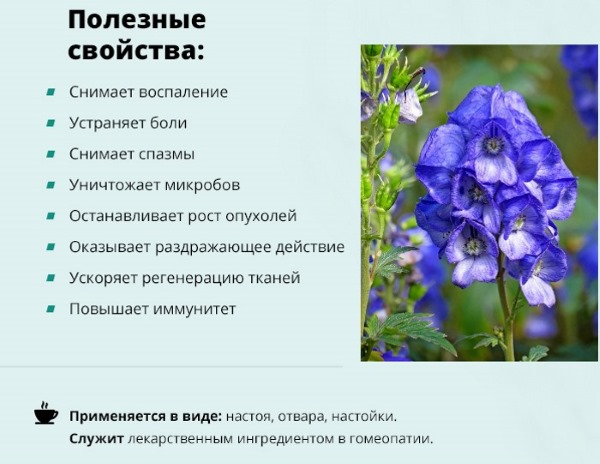
The composition of Aconite Beloustny contains the alkaloid lappaconitine hydrobromide, on its basis the drug "Allapinin" is produced, which helps with arrhythmias. In total, up to 10 types of alkaloids were found in the roots of white-tipped varieties, including:
- axinatin;
- mezaconitine;
- eccelazine.
The total content of alkaloids ranges from 1 to 4%. In no case should you self-medicate! Talk to your doctor before using any herbal preparations. In official medicine, aconite is not used at all, however, certain substances in the composition that block the development of certain cells are used in research to combat cancer (more details can be found in the research of Dr. A. Stork).
Possible harm and contraindications
The ancient Greeks claimed that the poisonous saliva of the underground dog Cerberus gave birth to the flower when Hercules dragged it to the surface.The Scandinavians believed that aconite grew on the site of the death of the god Thor, who died from the bites of a poisonous snake. In both myths, the main thing is emphasized - a wild plant is unusually dangerous, a potent poison is contained in all parts, including pollen and seeds. You can even get poisoned by inhaling the scent of a flower.
It is important to know the symptoms of aconite poisoning:
- decrease in pressure;
- temperature increase;
- heart rhythm disorder;
- the occurrence of vomiting.
For any of these symptoms that occur after working with a flower culture, you should see your doctor.

Contraindications for use:
- allergies and hypertension;
- pregnancy and breastfeeding;
- childhood.
Cultivated species that grow for a long time in fertile soil lose their toxic properties over time. And yet, children should not be allowed to come into contact with plantings.
Video "Aconite: types, agricultural technology and application"
This video examines the features of agricultural technology and the use of herbaceous perennials.
Common types and varieties of aconite
In landscape design, some types of plants are used. Here's a description of the popular ones:
- Klobuchkovy (blue aconite). Hybrid, stretches 30–130 cm. The foliage is green, glossy, seven-lobed. Blooms in June. Inflorescences are racemose, flowers are small, blue or blue. Cultured in the 17th century, used in a folk pharmacy.
- Karmikhela arentsi. Compact, grows up to 140 cm. The stem is upright, carved. The foliage is rich green. Inflorescences are high, massive, racemose, blue. Blooms in late September - early November.
- Aconite Dzhungarsky. Tall (up to 1.5 m). The foliage is dark green, oval-heart-shaped, consists of 3 three pointed lobes. The inflorescences are massive, dirty blue, combined into apical brushes. Blooms by mid-summer. The wild-growing species is widespread in Kazakhstan, China, Kashmir.
- Aconite is pharmacy. Tall (1.5 m). The foliage is palmate, dissected, dirty green. Blooms in the second half of summer. Inflorescences racemose, dark blue, stretching up to 50 cm.
- Aconite bicolor (two-color). The color of the inflorescences is peculiar, white and blue. The stem is tall, up to 1.5 m. The foliage is diamond-shaped, dark green. The culture blooms in the middle of summer.
- Karmichela arensi
- Klobuchkovy, or blue
- Aconite bicolor
- Dzungarian
The nuances of growing outdoors
The plant adapts equally well to sunny and shaded areas. However, there are certain cultivation and planting techniques.
Landing rules
In the place of planting, water should not accumulate after precipitation, otherwise measles begin to rot. Stony soil and sandstones are also not suitable - the soil should be light, loose.
During spring planting, when the earth warms up, the place is prepared - the soil is dug up, mixing organic fertilizers and peat. A hole is dug under each seedling, the size of which is slightly larger than the size of the root. If there are several seedlings, holes are dug in 70 cm increments. The bottom is drained by adding fine gravel or expanded clay. A layer of compost soil or mineral fertilizing is laid on top.
Landing is carried out according to the scheme:
- The seedling is placed in the middle of the hole and added dropwise, making sure that the root collar does not go deep into the ground - a couple of centimeters from the surface is enough.
- Easy to tamp with hand, watered abundantly.
- The plot is mulched with coniferous mass or sawdust. Mulch will allow heat and moisture to stay in the ground longer.
Reproduction methods
Reproduction is carried out in several ways:
- With the help of seeds. Several wilted flowers are left waiting for the seed to fully ripen. In the fall, seeds are simply sown into the soil, in centimeter holes, placing a layer of manure on top.
- By division. It is performed every four years so that the shrub does not grow. The bush is buried in, cut into pieces, making sure that the seedlings have 3-4 buds. The planting material is transferred to the prepared places and planted according to the previously described scheme.
- Tubers. Reproduction in this way is done in September and only for certain varieties. Each tuber is germinated, waiting for the appearance of buds, then planted in the ground.
- Cuttings. They are cut from young shoots, up to 15 cm long. They are performed in early May, preferably germinating in a greenhouse. When the first leaves appear, they can be planted in the ground.
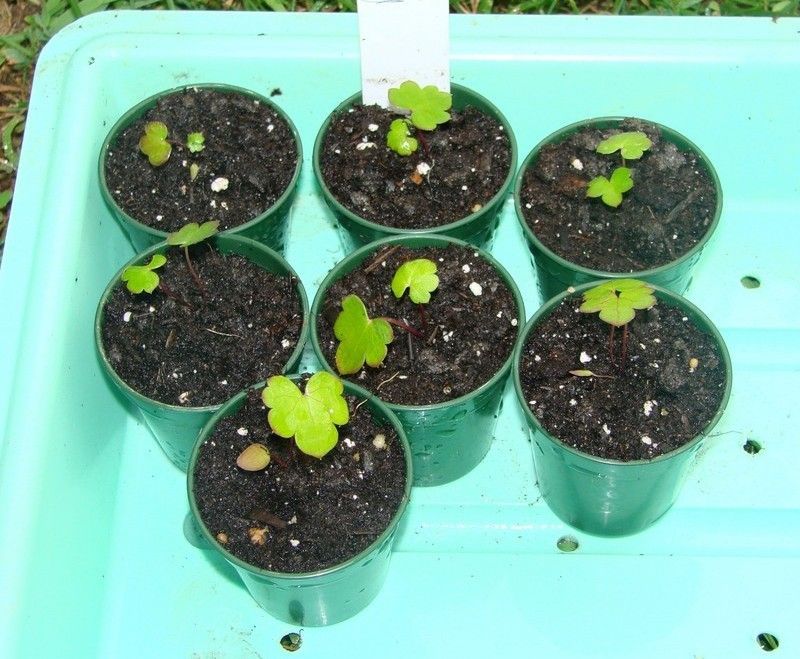
Care features
Aconite does not like waterlogging. Even in dry summers, it is enough to water the seedlings twice a month and this should be done only when the surface layer of the earth begins to dry out. The trunk circle is necessarily loosened after heavy rains or watering, allowing air to freely penetrate to the roots. When digging, they get rid of weeds that take away nutrients from the crop.
It is important to fertilize the soil at the planting site, since over the years it depletes in useful substances. You will need both mineral and organic fertilizers. Top dressing is applied twice:
- in spring - mixed with compost and poured under each bush.
- before flowering - according to the same pattern.
By cutting off the shrub, it is possible to achieve the necessary decorative effect. First of all, withering flowers are cut so that the plant does not waste nutrients, at the same time stimulating the culture to bloom again.
The culture is frost-resistant, but needs a winter shelter. In autumn, the stems are cut short, the near-surface circle is insulated with an additional 20 cm layer of dry peat. The fallen leaves are scooped up on top. In the spring, the shelter is removed so that the earth dries out faster.

Diseases and pests of aconite
Although the crop is poisonous, it attracts many pests. The most common are:
- aphids - for the fight, the plant is sprayed with Aktara insecticide;
- rape flower beetle - fight by periodic loosening of the soil;
- nematodes - when detected, the plants are treated with special preparations.
In addition to pests, common diseases, mainly viral and fungal, threaten aconite. The following are dangerous:
- Powdery mildew. It is necessary to cut off damaged shoots, replace the topsoil at the root. For prophylaxis they are sprayed with fungicides "Vitaros" or "Fundazol";
- Ring mosaic (carrier - aphid). The affected areas are cut off.
- Viral greening. The disease cannot be treated, the plant must be dug up and burned.
Collection, procurement and storage of raw materials
In folk medicine, the whole plant is used. The grass is harvested before flowering, the roots in October. The collection is carried out in the morning so as not to breathe in the poisonous aromas of essential oils. The collected plants are cleaned of lateral roots, washed, laid out to dry in one layer in a ventilated room.
You need to work with raw materials with gloves, try to avoid touching naked parts of the body. You can stay indoors for no more than 1.5-2 hours. Dried herbs should be stored in linen bags with the obligatory mark “Poisonous”.
The use of aconite in traditional medicine
Given the strong toxicity of the plant, in folk medicine it is used in small doses, mainly to fight infections. Drugs based on it help with:
- diseases of the joints and spine;
- purulent infections;
- parasitic skin lesions;
- disorder of the nervous system;
- rheumatism and neuralgia;
- sarcoma of the breast;
- abscesses;
- syphilis.

Aconite tinctures are made in different concentrations depending on the ailment. Tincture for the treatment of abscesses and ulcers is made according to the prescription:
- 20 g of dried raw materials are poured with a glass of boiling water;
- simmer on low heat for 20 minutes;
- allow to cool and filter;
- treat the affected areas.
In case of joint diseases, compresses are made from the tincture; wetting the gums helps from toothache. In oncology, aconite is used only to alleviate the condition. The tincture does not cure swelling, but relieves negative symptoms, helping the patient feel better.
The use of aconite in garden design
The flower is unusually beautiful, which makes it possible to use the culture in the design of garden landscapes. Even after the picturesque flowers wither, aconite attracts attention with its peculiar patterned leaves. The plant can be combined with lilies, peonies, delphiniums and rudbeckia. The result is a unique landscape flower bed that can transform any garden.
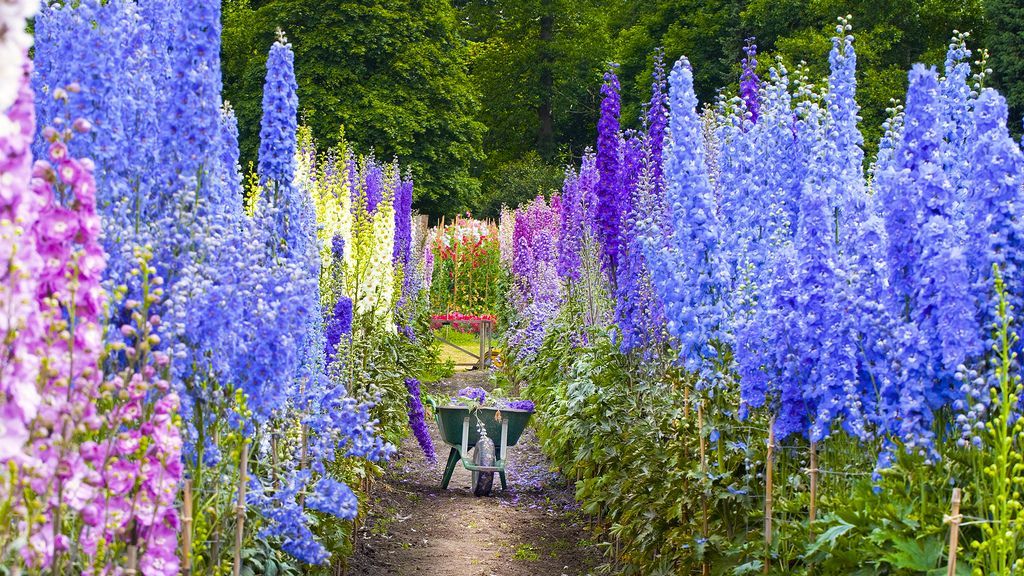
Aconite is not only picturesque and looks beautiful in garden design, it is also an effective assistant for many ailments. However, be aware of its toxic properties and always use caution.

